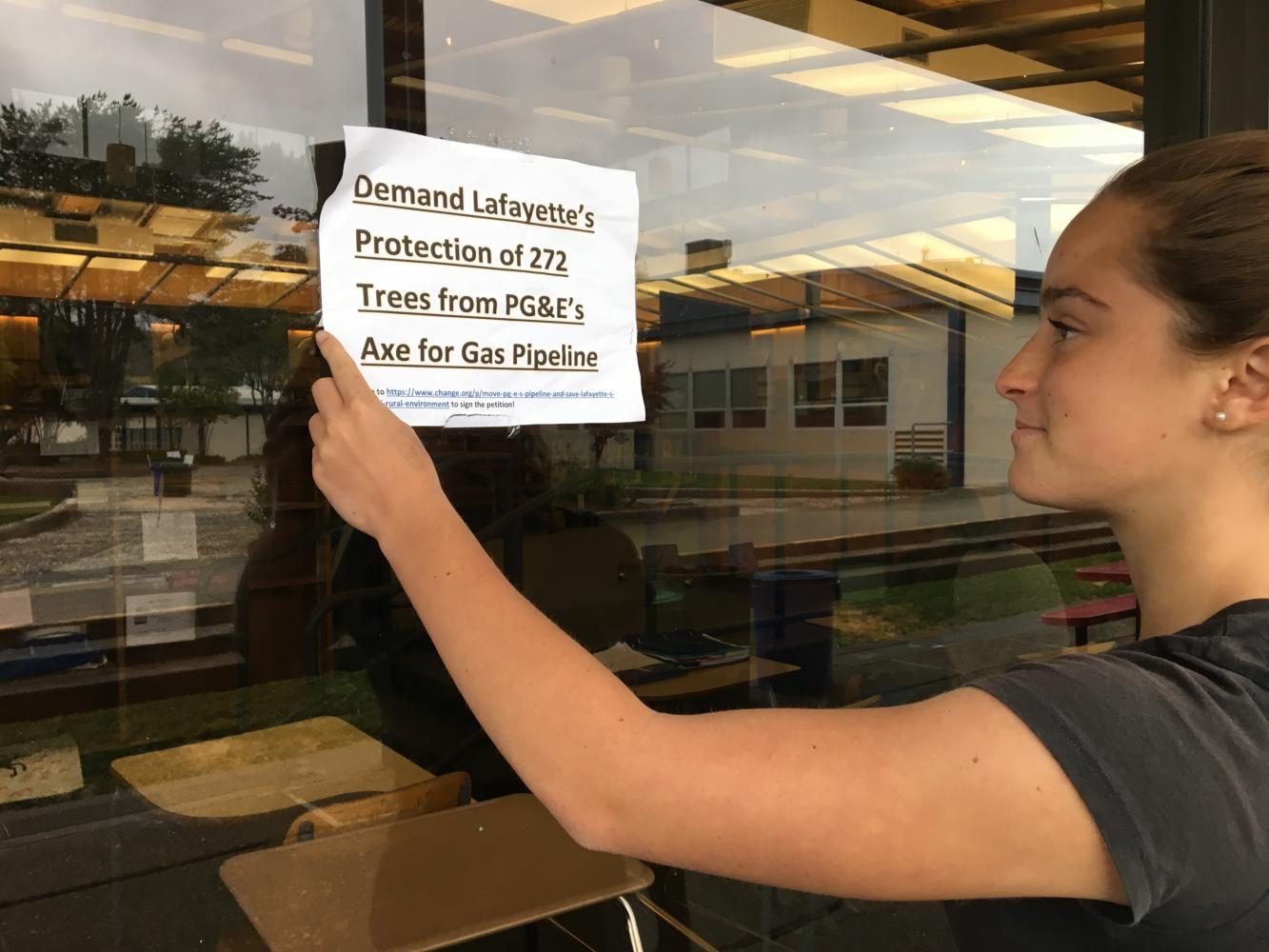Pipeline Installation Threatens Lafayette Trees
May 30, 2017
One signature spurred the people of Lamorinda into protest against the $500 million Community Pipeline Safety Initiative proposed by PG&E.
On March 27, the city of Lafayette and PG&E struck an agreement to build a gas pipeline through both public and private property near the Lafayette Moraga Regional Trail, calling for the removal of 272 oak trees.
Now, a petition started by a Lafayette resident Michael Dawson in opposition to the project has gained over 1,900 supporters.
Sophomore Kelsey Levante is an advocate for the local petition and has spreading awareness on campus and recruiting classmates to join the resistance. “I went and did some research and I figured out about this petition. The petition was the first thing that I found. It gave a really great summary about what PG&E is planning to do and why we’re against it,” she said.
The petition strongly urges the city of Lafayette and PG&E to alert every resident in Lafayette about their project and to “come up with a plan to shield the pipeline, or move the current pipeline five feet further into the trail, thereby eliminating the need for irreversible tree removal.”
Levante has posted flyers on campus regarding the PG&E project. “Even though we live in Moraga, I know a lot of students that come here who live in Lafayette; I live in Lafayette myself. I wanted people to know about what’s going on and if they wanted to sign the petition, I put the link at the bottom so people could easily sign it. Because sometimes students are so busy we don’t get to check up on the news as much and if I had the posters around campus, the people who may not see it when they’re out and about, they’ll see it here,” she said.
Sophomores Emily Tamkin and Claire Sebree joined Levante to speak out against the construction of the pipeline. According to Tamkin, she got involved when Levante “rallied Claire and I to try to spread the petition.”
Tamkin then alerted Environmental Science teacher, Tren Kauzer, about the pipeline. Kauzer said, “The more that I look into the situation, the more it seems like the removal of trees is not a necessary step. Maybe there are a few that need to be removed because their proximity is very close to the pipeline, 272 is a little ridiculous. And that came down from over a thousand.”
On May 23, Levante and Sebree went to the Lafayette city council meeting to voice their opposition to the pipeline in front of the city council.
Before the council meeting, Tamkin said the goal was to “inform the city council about why this is a misguided decision to allow the chopping of these trees. We also wish to gain more information as to why it was accepted as a proposition and how it’s gonna impact Lafayette and basically speak up.”
Levante said, “We both said our opinions and what we believed and why we think there is another way to be able to fix the gas pipeline without having to remove all the trees.”
PG&E was not at the council meeting, though the council members listened to the concerns. Levante said, “They didn’t really respond. They kinda just took notes and listened. There’s going to be another meeting in July before PG&E starts their work, and we’re really hoping that we’ll be able to convince the town council that they need to call this off.”
At the council meeting, Levante and Sebree met Dawson. “The guy who started the petition, who started getting everyone aware in Lafayette; he was there and we actually exchanged phone numbers and emails with him so we can further on. So we think, yeah, our speeches made a decent impact,” said Levante.
“It seems hypocritical for the city of Lafayette to be okay with this, allowing this, and to have authorized it. When you go to the city of Lafayette’s website, you see ‘Green Hills, Great Schools,'”said Kauzer. “‘Let’s keep our hills green.’ If that’s the tagline for Lafayette, it seems a little ridiculous that they want to get rid of these state-protected, beautiful trees.”
Tamkin added, “The trees do not need to be cut down. There are no issues with accessibility, seeing as the pipeline could easily be moved to right beneath the trail and there are no problems with roots invading the pipeline and causing danger. The only problem would be faulty PG&E welding.”
According to Tamkin, Lamorinda residents were shocked when they found out about PG&E’s plan to install the pipeline. “The citizens of Lafayette did not know about this. A lot of people I’ve talked to told me they’d never heard about it,” she said.
“PG&E was trying to do this under the radar, and do this without people noticing. It sounds like they weren’t educating the public, I could be wrong here, but the [organization], Save Lafayette Trees, has been… doing the education campaign. It doesn’t really sound like PG&E was going to be really forthcoming with that information,” Kauzer said.
“Letting students at Campo know is important because there are students here who walk on the trail or ride their bike on the trail and think that the trees are beautiful. Maybe they live right next to the trail. The more people that know, whether they are the homeowners, adults, voting age or not, the higher the chance that some of these trees might be saved,” added Kauzer.
Levante said, “No matter if you’re really into politics, or if you’re really into history, environmentalism is a problem that all of us should be aware of…We all need to help each other out when it comes to these issues because only if small groups fight for certain issues, then we’re not gonna get anywhere. But if everyone helps each other for the big issues that we’re all passionate about, we’re all gonna get somewhere. Even the students who aren’t so much environmentalists, it’s important that they understand because they may want to understand what’s going on and help out.”

